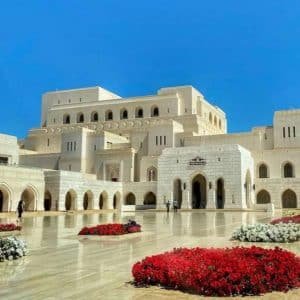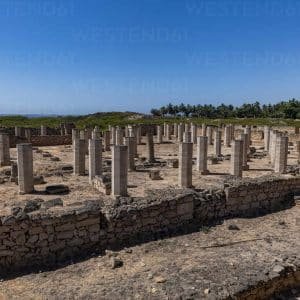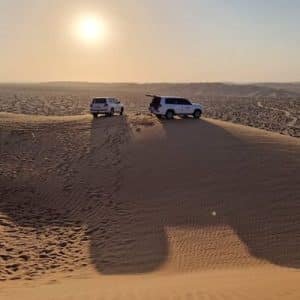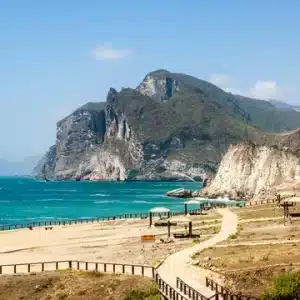Table of Contents
ToggleGo Salalah: 21 Must-Know Travel Secrets to Discover Oman’s Green Paradise

When you decide to Go Salalah Travel , you’re in for a surprise unlike any other in the Arabian Peninsula. This lush green city in southern Oman is where monsoon clouds descend upon dry deserts, camels roam under coconut palms, and the air smells of frankincense and rain. Unlike the rest of Oman, Salalah enjoys a unique microclimate, particularly during the Khareef season, when the city becomes a verdant paradise.
A world away from the towering skyscrapers and arid dunes that define much of the Gulf, Salalah offers visitors cool breezes, misty mornings, cascading waterfalls, and a slow pace of life. Whether you’re an adventurer, history buff, nature lover, or beachcomber, there’s something magical waiting for you here.
When to Go Salalah
The Khareef season (June to September) is the best time to go Salalah. This is when the city transforms into a misty, green wonderland. Temperatures drop to around 23–26°C, and the hills bloom with greenery. If you prefer sunshine and diving conditions, visit during October to April when the weather is dry and ideal for swimming, snorkeling, and hiking.
How to Go Salalah
Salalah is easily accessible by:
Flight: Direct flights from Muscat, Dubai, Doha, and several Indian cities
Road trip: A scenic but long journey (12–14 hours) from Muscat
Bus: Mwasalat offers affordable long-distance buses from major Omani cities
For local travel, renting a car—preferably a 4WD—is highly recommended. It gives you the freedom to explore remote waterfalls, mountain villages, and coastal beaches.
Salalah’s Monsoon Magic
During Khareef, Salalah is draped in fog and drizzled by light showers. The brown hills turn emerald, waterfalls spring to life, and the landscape becomes ethereal. It’s not just beautiful—it’s surreal. You’ll witness nature’s dramatic transformation, a rare event in this part of the world.
Local legends, mist-covered plateaus, and the sound of waterfalls add a mystical charm. It’s a photographer’s dream and a nature lover’s heaven.
Essential Packing Guide
What should you pack when you go Salalah?
Light rain jacket and quick-dry clothes (for Khareef)
Hiking shoes for mountain trails and wadis
Swimwear for beaches and waterfalls
Camera with lens wipes (the mist can fog things up)
Sunscreen & sunglasses for post-Khareef months
Modest clothing for cultural respect, especially at mosques
Salalah’s Best Beaches
Whether you want to relax or snorkel, Salalah’s beaches are pure bliss:
Al Mughsail Beach: Blowholes, scenic cliffs, and white sand
Al Fazayah Beach: Hidden gem with turquoise waters
Taqah Beach: Family-friendly and great for evening walks
Pack a picnic and stay till sunset—you won’t regret it.
Natural Springs and Waterfalls
Waterfalls and springs gushing from rocky hills are Salalah’s pride:
Wadi Darbat: A must-visit for kayaking and scenic boat rides
Ayn Khor and Ayn Athum: Lush hideouts perfect for a quiet day out
Ayn Razat: Fed by a natural spring, ideal for photos and walks
Most of these come alive during and after Khareef, making timing crucial.

Frankincense Legacy
Salalah is the historic heart of the frankincense trade. Once more valuable than gold, frankincense has shaped trade routes, religious practices, and local identity for centuries.
Visit the Wadi Dawkah Reserve, where frankincense trees still grow wild. Learn how this sacred resin is harvested, and don’t miss a stop at the Museum of the Frankincense Land, part of the UNESCO-listed Al Baleed site. Pick up souvenirs like incense, oils, and burners from local markets.
Top Tourist Attractions
Salalah is teeming with historical landmarks and serene spots:
Sultan Qaboos Mosque: A majestic place of worship with stunning architecture
Al Baleed Archaeological Park: Ruins of a once-thriving port city
Sumhuram Ruins at Khor Rori: A mythical city linked to the Queen of Sheba
Salalah Anti-Gravity Point: A roadside curiosity where cars roll uphill
Each location offers a unique perspective into the past and present of Salalah.
Where to Stay in Salalah
From opulent resorts to homely guesthouses, Salalah has options for every budget:
| Type | Examples |
|---|---|
| Luxury | Al Baleed Anantara Resort, Hilton Salalah |
| Mid-range | Salalah Rotana Resort, Fanar Hotel |
| Budget | Star Emirates Hotel, Al Nile Hotel |
| Family stays | Coconut Farm stays, Airbnbs with local hosts |
Book in advance during Khareef season to secure the best spots.
Salalah’s Khareef Festival
A grand event held annually from July to early September, the Khareef Festival celebrates the region’s monsoon and heritage:
Cultural shows, live Omani music, and folk dances
Food stalls featuring regional specialties
Amusement parks and kids’ activities
It’s a great time to go Salalah with family, especially if you enjoy lively atmospheres.
Best Food to Try When You Go Salalah
Omani cuisine is as rich as its culture:
Shuwa: Slow-cooked lamb marinated in spices and roasted underground
Majboos: Spiced rice with chicken or lamb
Harees: A porridge-like dish with meat and wheat
Halwa: A sticky sweet dessert infused with saffron and rosewater
Street vendors along the corniche also sell fresh coconut water and spicy corn-on-the-cob.
Souks and Markets
Shopping in Salalah is an experience:
Al Husn Souq: Best for frankincense, perfumes, and silver jewelry
Salalah Grand Mall: Modern options with restaurants and stores
Traditional markets in Mirbat: For handwoven fabrics and local snacks
Don’t hesitate to bargain—it’s expected and fun.
Road Trips from Salalah
Add more adventure to your itinerary:
Mirbat: A peaceful fishing village with historic forts
Jebel Samhan: High-altitude viewpoint with dramatic cliffs
Rub al Khali (Empty Quarter): One of the world’s largest sand deserts
A day or two exploring these areas adds a rugged edge to your otherwise tranquil vacation.
Travel Photography in Salalah
Capture breathtaking scenes like:
Fog-covered Jebel Qara during Khareef
Camel herds grazing beneath banana palms
Sunsets at Al Fazayah Beach
Frankincense smoke swirling in ancient souks
Use wide-angle lenses and be patient—Salalah rewards those who wait.
Eco Travel and Sustainability
Salalah’s natural beauty demands respectful tourism:
Avoid single-use plastics and littering in wadis or on beaches
Choose locally-run eco lodges
Support conservation-focused guides and businesses
Together, we can preserve Salalah’s pristine charm for future travelers.
Wildlife in Salalah
Don’t be surprised to see:
Camels on the beach
Ibex and mountain goats in Jebel Samhan
Birds like flamingos and eagles
Dolphins playing off the Mirbat coast
Animal lovers will find much to enjoy here—just keep your distance and don’t feed the wildlife.
Exploring Wadis and Mountains
The wadis are the veins of Salalah’s wild heart:
Wadi Darbat: Ideal for beginners and families
Wadi Hinna: More secluded and wild
Jebel Qamar trails: Challenge your hiking limits
Go early in the morning for the best experience—and always bring water.
Family Travel to Salalah
Traveling with kids? No problem:
Beaches are safe and shallow
Hotels offer play areas and pools
Activities like pony rides and picnic areas abound
It’s a stress-free destination for families wanting nature and culture.
Common Travel Mistakes to Avoid
Skipping Khareef season: You’ll miss Salalah’s magic
Not booking early: Hotels fill up months in advance
Ignoring local customs: Dress modestly and ask before taking photos
Avoiding these pitfalls ensures a smooth and respectful journey.
FAQs
What’s the best time to go Salalah?
June to September (Khareef) for lush landscapes; October to April for beach activities.
Is Salalah expensive to travel?
It can be affordable with budget stays and local eateries, though flights can be pricey during peak season.
Can I drink tap water in Salalah?
It’s best to stick to bottled water.
Do I need a visa to go Salalah?
Yes, most tourists need an eVisa. Check Royal Oman Police’s website.
What language is spoken in Salalah?
Arabic is the main language, but English is widely understood.
Is Salalah safe for solo travelers?
Absolutely. Oman is known for its hospitality and low crime rates.







Comment (0)